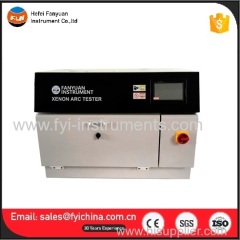
Xenon Weather Conditions Test Chambers
3500.0~7500.0 USD
| Min. Order: | 1 Piece/Pieces |
|---|---|
| Trade Term: | FOB |
| Payment Terms: | T/T |
| Supply Ability: | 3000pcs/year |
| Place of Origin: | Guangdong |
Company Profile
| Location: | Dongguan, Guangdong, China (Mainland) |
|---|---|
| Business Type: | Manufacturer |
| Main Products: | Environmental Test Chambers |
Product Detail
| Model No.: | ZXSL-100L |
|---|---|
| Means of Transport: | Ocean |
| Usage: | Universal Testing Machine |
| Power: | Electronic |
| Brand Name: | ZHIXIANG |
| Design: | Customized |
| Production Capacity: | 3000pcs/year |
| Packing: | 1pcs machine packed in 1 wooden case |
| Delivery Date: | 20days |
Product Description
Xenon Weather Conditions Test Chambers
Usages:
Used to test non-ferrous, organic, rubber, plastic and building materials under illumination, rain, condensation, hot and cold, dry and humidity, wind and other climatic changes. It can provide data for users to evaluate the products' properties and quality performance in order to improve the product quality.
Applied Standards:
1, ASTM G155: Practice for Operating Xenon Arc Light Apparatus for Exposure of Non-Metallic Materials
2, ASTM D2565: Standard Practice for Xenon-Arc Exposure of Plastics Intended for Outdoor Applications
3, ASTM D4459: Standard Practice for Xenon-Arc Exposure of Plastics Intended for Indoor Applications
4, ASTM D6695: Standard Practice for Xenon-Arc Exposures of Paint and Related Coatings
5, ASTM D7356: Standard Test Method for Accelerated Acid Etch Weathering of Automotive Clear coats Using a Xenon-Arc Exposure Device
6, ASTM D750: Standard Test Method for Rubber Deterioration Using Artificial Weathering Apparatus
7, ISO 4892-1: Plastics – Methods of Exposure to Laboratory Light Sources – Part 1: General guidance
8, ISO 4892-2: Plastics - Methods of Exposure to Laboratory Light Sources - Part 2: Xenon-arc lamps
9, ISO 11341: Paints and Varnishes - Artificial weathering and exposure to artificial radiation- Exposure to filtered xenon-arc radiation
10, SAE J2412: Accelerated Exposure of Automotive Interior Trim Components Using a Controlled Irradiance Xenon-Arc Apparatus
Usages:
Used to test non-ferrous, organic, rubber, plastic and building materials under illumination, rain, condensation, hot and cold, dry and humidity, wind and other climatic changes. It can provide data for users to evaluate the products' properties and quality performance in order to improve the product quality.
Features:
1. Full Spectrum Xenon Lamps: Xenon arc lamps give the best reproduction of full-spectrum of natural sunlight.
2. Temperature Monitoring & Control: temperature control refers to the degradation rate.
3. Large Specimen Capacity: The test chambers have a higher specimen capacity than other test chambers.
4. Humidity Control: Standard Relative Humidity (RH) control
5. Options: Water Spray: Outdoor moisture attack is simulated via an optional pure water spray in the test chamber
1. Full Spectrum Xenon Lamps: Xenon arc lamps give the best reproduction of full-spectrum of natural sunlight.
2. Temperature Monitoring & Control: temperature control refers to the degradation rate.
3. Large Specimen Capacity: The test chambers have a higher specimen capacity than other test chambers.
4. Humidity Control: Standard Relative Humidity (RH) control
5. Options: Water Spray: Outdoor moisture attack is simulated via an optional pure water spray in the test chamber
Applied Standards:
1, ASTM G155: Practice for Operating Xenon Arc Light Apparatus for Exposure of Non-Metallic Materials
2, ASTM D2565: Standard Practice for Xenon-Arc Exposure of Plastics Intended for Outdoor Applications
3, ASTM D4459: Standard Practice for Xenon-Arc Exposure of Plastics Intended for Indoor Applications
4, ASTM D6695: Standard Practice for Xenon-Arc Exposures of Paint and Related Coatings
5, ASTM D7356: Standard Test Method for Accelerated Acid Etch Weathering of Automotive Clear coats Using a Xenon-Arc Exposure Device
6, ASTM D750: Standard Test Method for Rubber Deterioration Using Artificial Weathering Apparatus
7, ISO 4892-1: Plastics – Methods of Exposure to Laboratory Light Sources – Part 1: General guidance
8, ISO 4892-2: Plastics - Methods of Exposure to Laboratory Light Sources - Part 2: Xenon-arc lamps
9, ISO 11341: Paints and Varnishes - Artificial weathering and exposure to artificial radiation- Exposure to filtered xenon-arc radiation
10, SAE J2412: Accelerated Exposure of Automotive Interior Trim Components Using a Controlled Irradiance Xenon-Arc Apparatus






